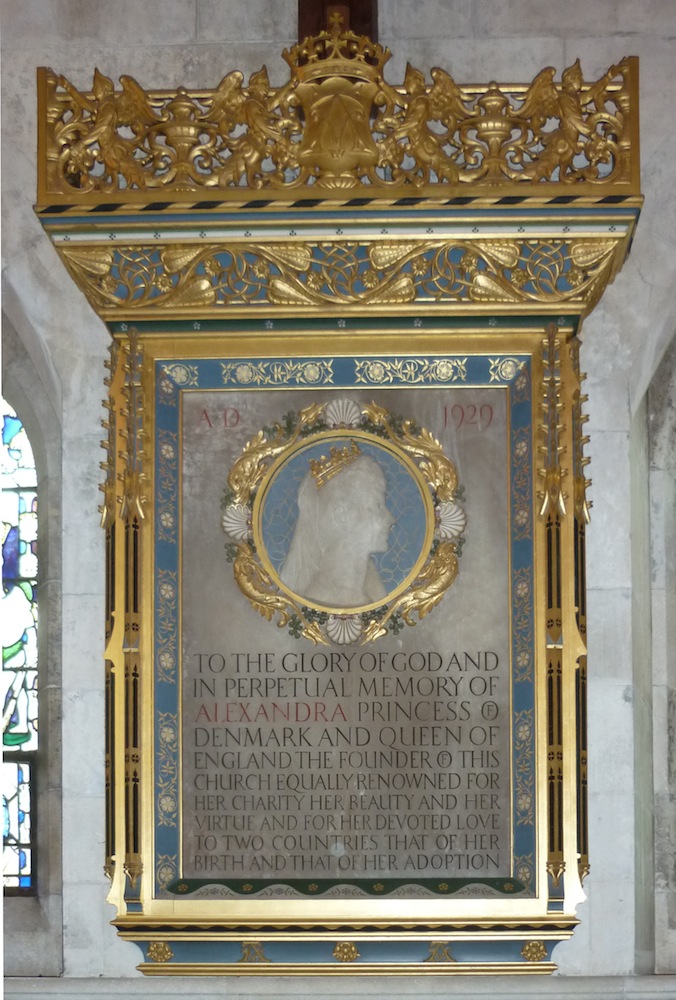
St. Alban's Church. Architect, Sir Arthur Blomfield, built 1885-1887 of flint with limestone dressings and a granite tower, in Churchill Park, Copenhagen, Denmark. Photographs and text by Jacqueline Banerjee. You may use these images without prior permission for any scholarly or educational purpose as long as you (1) credit the photographer and (2) link your document to this URL in a web document or cite the Victorian Web in a print one. Click on the images to enlarge them, and for more information where available.


Left: Entrance through south porch below tower. Right: Interior, looking east.
This late Victorian Gothic Revival church is very pleasantly situated in the park by Copenhagen's famous harbour. In the nineteenth century, the town had become more and more of a commercial centre, and an English congregation had developed there. So when the Prince of Wales married Princess Alexandra of Denmark in 1863, the couple set about raising money to erect a suitable church: Princess Alexandra herself is considered its founder. Sir Arthur Blomfield was selected to design it, and the design was executed by a Danish artchitect, Professor L. Fenger. The idea as to build the church just as it might be built in England, but the materials used seem to have been particularly fine. The effect is light and appealing.


Left: Tablet commemorating Edward VII, who had been present at the consecration as Prince of Wales, with Princess Alexandra. Right: Plaque commemorating Queen Victoria's Diamond Jubilee, given by the British people living in Denmark at that time, "in thankfulness for sixty years' beneficent reign of Queen Victoria" — with attractive tiling below.
Many dignitaries gathered for the consecration on 17 September 1887, including the Prince and Princess of Wales themselves, and the Danish Crown Prince and Princess Marie of Denmark, as well as the King and Queen of Denmark, The Czar and Czarina of Russia, and the King and Queen of Greece. Members of other foreign royal families also attended, along with the "entire Diplomatic Corps, Ministers and representative from Army and Navy, Church Officials, as well as Greek, Russian and Roman Catholic Priests" ("About the Church Building").



Fittings by George Tinworth of Doulton's. Left to right: (a) Font. (b) Pulpit. (c) Reredos.
There is also a very attractive memorial plaque to Princess Alexandra (shown on the right here).
The font, pulpit and reredos were presented to the church by the Doulton Company of Lambeth. Some sources credit George Tinworth simply with "panels in the pulpit and reredos" (e.g. Bedford and Rose), but the church's own website includes the font. Its front panel is very obviously by Tinworth (compare it, for instance, with his relief of the Good Samaritan for the St John Ambulance Brigade).

Opposite Edward VII's memorial plaque is another, paying tribute to Princess Alexandra, who died in 1929, as the founder of the church. Shown on the right here, it is particularly attractive — made of different materials, and in this respect very representative of its era. The inscription praises her for her devotion both to the country.of her birth and her adopted country, as well as to her charity and beauty.
Sources
"About the Church Building" (St Alban's website). Web. 17 September 2016.
Bedford, R. P., rev. Peter Rose. "Tinworth, George (1843-1913)." Oxford Dictionary of National Biography. Online ed. Web. 17 September 2016.
St Alban's Church, Copenhagen. Leaflet available in the church.
Last modified 17 September 2016